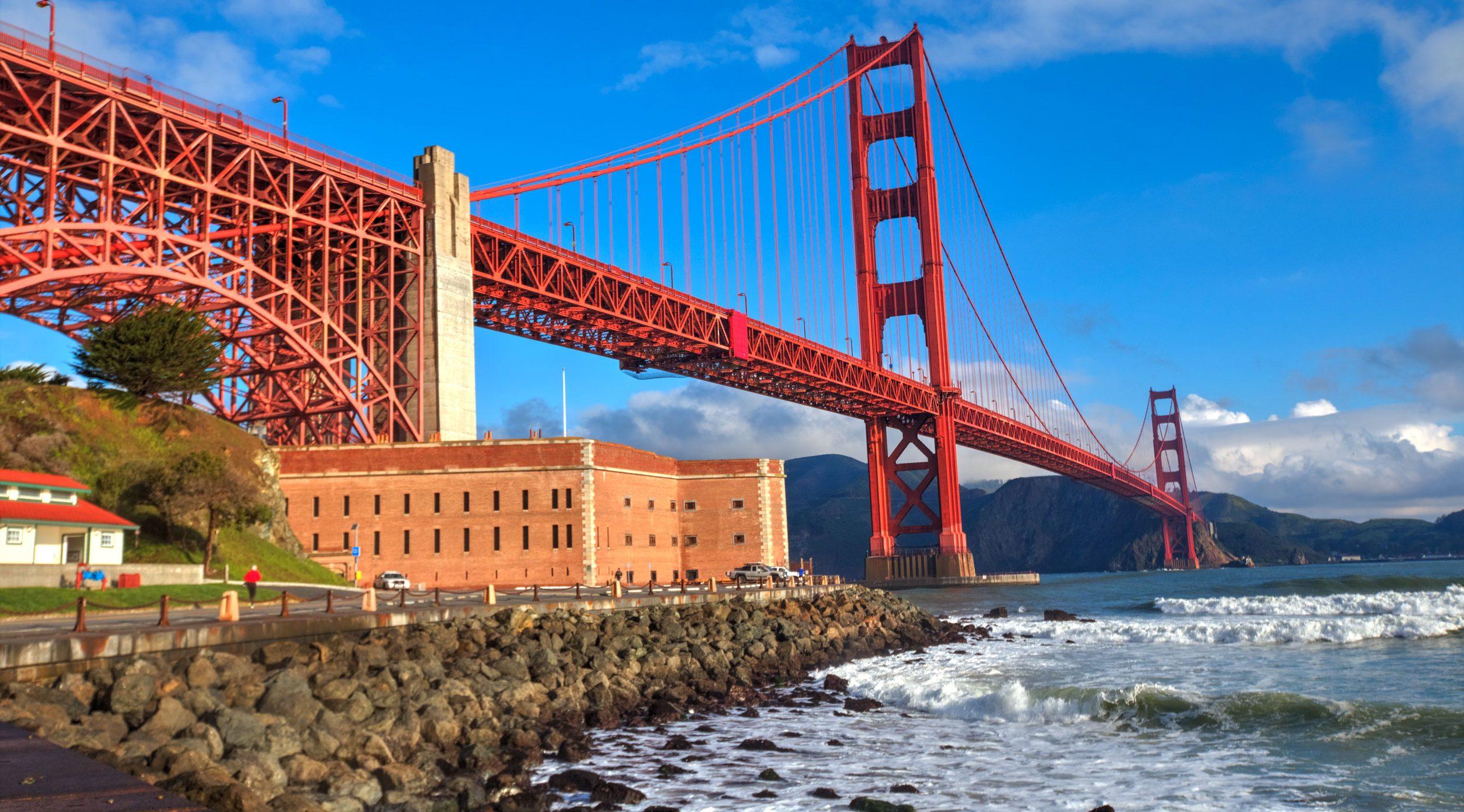Fort Point National Historic Site
Fort Point is a signature landmark located beneath the Golden Gate Bridge southern approach.
When Alfred Hitchcock thinks you’re a star, you’ve got to be doing something right!
Such is the reputation of Presidio’s Fort Point National Historic Site, which made a memorable cameo in Hitchcock’s 1958 masterpiece, Vertigo. Built beginning in 1853 at the height of California’s Gold Rush, the structure was later utilized in the Civil War, then again in World War II before ultimately becoming a National Park Site in 1970.
Today, Fort Point remains a popular tourist destination thanks to its unique history, Third System coast defense architectural style, and word-class scenic views.
Black Gold: Stories Untold
This summer at Fort Point, see FOR-SITE’s highly anticipated exhibition Black Gold: Stories Untold. This exhibition invites 17 contemporary artists and collectives to reflect on the resilience, struggles, and triumphs of African Americans who lived in California from the Gold Rush to the Reconstruction period following the Civil War (c. 1849–1877). Through newly commissioned and recent artworks, the exhibition highlights important but lesser-known figures and narratives from California’s history, exploring the presence of slavery and the struggle for legal rights within this “free” state, the successes of Black entrepreneurs, and the experiences of African American Army regiments known as the Buffalo Soldiers.
Exhibits
Discover the legacy of Fort Point, a storied fortress guarding the entrance to San Francisco Bay, through a captivating new exhibit. Delve into its strategic design and unravel the evolving symbolism within its casemates. Each exhibit offers a distinct viewpoint on the fort’s history and relevance.
Exhibit Areas:
Sally Port:
Discover the ingenious design of Fort Point’s entrance, strategically constructed to limit enemy access and bolster defense capabilities. Visitors can envision the scene as soldiers stand vigilant atop elevated banquets, ready to defend the fort if needed.
Guard Room:
Delve into the multifaceted significance of Fort Point throughout history, from its role in military conquest to its status as a symbol of California’s early history and contemporary community hub.
Magazine 1: Why Here?
Explore the strategic importance of Fort Point in controlling access to San Francisco Bay and its vital resources, tracing its history from the Ohlone peoples to Spanish colonization and beyond.
Magazine 2: Who Worked Here?
Learn about the diverse array of individuals who contributed to Fort Point’s construction and operation, including soldiers, civilians, and marginalized groups like African American cooks during the Civil War.
Magazine 3: Life at Fort Point
Gain insight into the daily routines and challenges faced by soldiers stationed at Fort Point during the Civil War, where the harsh environment posed a greater threat than Confederate forces.
Casemates 1–3: A Changing Symbol
Trace the evolution of Fort Point’s significance over time, from a symbol of federal strength during the Civil War to its transformation into a cherished landmark and preservation effort in modern times.
Archway Exhibits: Then and Now
Reflect on the spirit of service and duty embodied by those who served at Fort Point throughout history, as well as the ongoing efforts of volunteers, park rangers, and preservationists to maintain its legacy for future generations.
Getting to Fort Point National Historic Site
Fort Point National Historic Site, 201 Marine Drive, San Francisco, CA 94129
By Presidio Go Shuttle
There is no direct shuttle service to the fort. To minimize your walk, head to Presidio Transit Center and take a 43 Masonic Muni to Lombard Street & Divisadero Street then transfer for free to an outbound 28 19th Avenue Muni bus and take it two stops to the Golden Gate Bridge parking lot.
Parking
Limited free spots are available at the Golden Gate Bridge lot. Additional parking can also be found near the Warming Hut Park Store and Café. If you’re up for a walk, enjoy features like Presidio Tunnel Tops and Crissy Field by strolling to Fort Point from our Main Post area via the stunning Bay Trail.
Why We Love Fort Point National Historic Site
On any given day, visitors may encounter “soldiers” taking part in a Civil War reenactment or glimpse a romantic proposal taking place. It’s all part of the magic at Fort Point National Historic Site, where tourists, hikers, and history buffs alike regularly gather to learn and explore.
Accessibility
Fort Point offers numerous amenities, including accessible parking, on-site restrooms, accessible entrances, assistive listening devices (ALDs) and open captioning materials.
Insider Tip
Fort Point is a gorgeous place to visit during the day, but for a whole new vision of this historic structure, consider booking a spot on one of our popular Candlelight Tours. Led by a park ranger, these 90-minute excursions offer a fun, fascinating opportunity for visitors ages 12 and up to see all four levels of the fort (including the roof!) from a fresh yet shadowy perspective. To learn more and purchase tickets, visit www.recreation.gov.
Frequently Asked Questions
Fort Point National Historic Site is open Thursday through Monday, 10 a.m. to 5 p.m.
The official address for Fort Point National Historic site is 201 Marine Drive.
Service dogs are allowed at Fort Point. Additionally, dogs on leash are allowed on Fort Point lands but not within the historic fort.
Fort Point sits under the Golden Gate Bridge’s southern exposure. To access the fort from Golden Gate Bridge Plaza, take the steps down to the Battery East trailhead and follow the road to Fort Point National Historic Site from there.
No. Entrance to Fort Point is free, though some guided tours and other special events may require ticket purchase for entry. Learn more here.
The most famous example is Alfred Hitchcock’s “Vertigo,” though the list is far longer than that! Other examples of films to feature Fort Point include 1947’s “Dark Passage” and 1967’s “Point Blank.”
Explore What's Nearby
TAGS
Experience the Presidio
The Presidio is San Francisco’s national park site, with endless trails, fun events, and unforgettable vistas of the Golden Gate Bridge.
